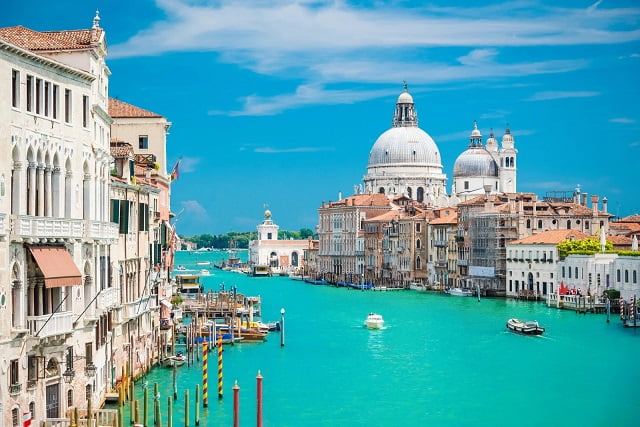When are US citizens allowed to travel to Italy? For many, the prospect of visiting this stunning European destination is an exciting opportunity that they have been eagerly awaiting. However, the impact of the COVID-19 pandemic has led to various travel restrictions and requirements that need to be considered before planning a trip to Italy.
As the world continues to navigate through the pandemic, understanding the current travel restrictions and guidelines is crucial for anyone considering a trip to Italy. From visa requirements to testing and documentation, there are several factors that US citizens need to be aware of before making travel plans.
In this article, we will explore the latest updates and resources regarding travel policies for US citizens visiting Italy. From vaccination and testing guidelines to quarantine measures upon arrival in Italy, we will provide valuable information to help you navigate the process smoothly and safely. Additionally, we will offer tips for a seamless travel experience while looking forward to the possibility of traveling to Italy again.
Current Travel Restrictions
Italy, known for its rich history, delectable cuisine, and stunning landscapes, has long been a favorite travel destination for US citizens. However, due to the global COVID-19 pandemic, travel restrictions have significantly impacted the ability of Americans to visit Italy. As a result, it’s important for anyone considering traveling to Italy to understand the current restrictions and requirements in place.
As of now, US citizens are allowed to travel to Italy for essential reasons only. This includes work, health reasons, study, or absolute necessity. Tourism is not considered an essential reason for travel at this time. Additionally, entry into Italy from the United States is subject to further restrictions and may require specific documentation and testing.
The impact of the pandemic has led to a constantly evolving situation regarding travel restrictions and requirements. It is vital for US citizens considering travel to Italy to stay informed about the latest policies from both the Italian government and the US State Department. By staying up-to-date on current regulations and guidelines, travelers can better navigate the complexities of international travel during this time.
| Travel Restrictions | Current Status |
|---|---|
| Essential Travel | Allowed (e.g. work, health reasons, study) |
| Tourism | Not considered essential at this time |
| Entry Requirements | Subject to further restrictions and may require documentation/testing |
Requirements for Traveling to Italy
Italy is a captivating destination for travelers, offering an abundance of history, culture, and art to explore. For US citizens who are eager to visit Italy, it is essential to understand the current travel restrictions and requirements in place due to the impact of the COVID-19 pandemic.
As of the latest update, US citizens are allowed to travel to Italy for tourism or business purposes. However, there are specific requirements that must be met before embarking on this journey. Firstly, travelers from the United States must have a valid passport and may be required to obtain a visa depending on the duration and purpose of their visit. It’s crucial to check the visa requirements and application process well in advance.
In addition to visa requirements, US citizens traveling to Italy are also subject to testing and documentation guidelines. Currently, travelers must provide proof of a negative COVID-19 test taken within a certain timeframe before their departure. This requirement helps ensure the safety of both visitors and residents in Italy. It’s important for travelers to stay updated on any changes or updates to these guidelines as they plan their trip.
| Requirement | Description |
|---|---|
| Valid Passport | Essential for entry into Italy |
| Visa | May be required based on purpose and duration of visit |
| Negative COVID-19 Test | Must be obtained within specific timeframe before departure |
Vaccination and Testing Guidelines for US Citizens Traveling to Italy
As of the latest update, Italy has specific guidelines in place for US citizens traveling to the country. These guidelines are aimed at ensuring the safety of travelers and residents amidst the ongoing pandemic. Understanding the vaccination and testing requirements is crucial for US citizens planning a trip to Italy.
Vaccination Requirements
In order to travel to Italy, US citizens must provide proof of full vaccination against COVID-19. The Italian government recognizes vaccines that have been authorized by the European Medicines Agency (EMA) or listed for emergency use by the World Health Organization (WHO). It is important for travelers to ensure that their vaccination status meets these criteria before departing for Italy. Additionally, travelers are advised to carry their vaccination card as proof upon arrival.
Testing Guidelines
In addition to vaccination, US citizens traveling to Italy are also required to present a negative COVID-19 test result. The test must be taken no more than 72 hours before entering the country. Travelers should plan accordingly and schedule their tests within the specified timeframe to avoid any issues with entry into Italy. It’s important to note that even fully vaccinated individuals are still subject to this testing requirement.
Additional Measures
It’s important for US citizens traveling to Italy to stay informed about any updates or changes in the country’s travel policies related to COVID-19. This may include additional health screenings, quarantine regulations, or other measures implemented by Italian authorities. Staying updated on these measures will help ensure a smooth and hassle-free travel experience when visiting Italy.
Quarantine and Health Measures
Traveling to Italy has always been an exciting endeavor for US citizens, with its rich history, delicious cuisine, and stunning sights. However, due to the impact of the COVID-19 pandemic, there have been travel restrictions in place that have affected the ability for US citizens to visit Italy.
As the situation continues to evolve, it’s important to stay informed about when US citizens are allowed to travel to Italy and what health measures and quarantine requirements they can expect upon arrival.
When traveling to Italy as a US citizen, it is crucial to be aware of the current travel restrictions and requirements set forth by the Italian government. As of now, Italy allows entry for non-essential travel from countries including the United States, but certain requirements must be met in order to enter the country safely.
Here are some key things US citizens should expect when traveling to Italy:
- Proof of vaccination or negative COVID-19 test: Before entering Italy, US citizens must provide proof of being fully vaccinated against COVID-19 or a negative COVID-19 test result.
- Quarantine guidelines: Depending on vaccination status and specific circumstances, travelers may be required to quarantine upon arrival in Italy. It is important for US citizens to familiarize themselves with the current quarantine guidelines before traveling.
- Health measures: Upon arrival in Italy, US citizens can expect health screenings at airports as well as other health measures such as mask mandates and social distancing requirements.
Staying up-to-date on these quarantine and health measures is essential for US citizens planning a trip to Italy in order to ensure a smooth and safe travel experience. It’s important for travelers to check with their airlines and review official resources from both the United States government and Italian government before embarking on their journey. This will help ensure that they are well-prepared for their trip and remain compliant with all necessary health protocols.
Airlines and Travel Options
With the ongoing uncertainty surrounding travel restrictions and guidelines due to the COVID-19 pandemic, many US citizens are eager to know when they will be allowed to travel to Italy. As of now, Italy has implemented strict entry requirements for travelers, including those from the United States. However, there are certain possibilities and options for US citizens who wish to visit Italy in the near future.
Here are some key points regarding airlines and travel options for US citizens navigating their way to Italy:
- Currently, major airlines such as Delta, American Airlines, and United Airlines offer direct or connecting flights from various cities in the US to major airports in Italy, including Rome (Fiumicino) and Milan (Malpensa). It is important for travelers to stay updated on flight schedules and any potential changes due to evolving travel restrictions.
- In addition to commercial airlines, some charter companies offer private jet services for those seeking a more personalized and exclusive travel experience. While this option may come with a higher price tag, it provides flexibility and privacy for travelers concerned about crowded airports or shared spaces on commercial flights.
- For US citizens who prefer traveling by sea, cruise lines also offer itineraries that include stops in Italian ports such as Venice, Naples, and Genoa. However, it is essential to check with the cruise line regarding their specific protocols and health measures for passengers before embarking on a journey to Italy.
Despite the current limitations on travel to Italy for US citizens, there are still viable options available through commercial airlines, private jet services, and cruise lines. It is important for travelers to closely monitor updates from both the Italian government and transportation providers when planning their trip. Additionally, being prepared with proper documentation and adhering to health guidelines will help ensure a smooth and safe travel experience when visiting Italy.
Updates and Resources
As travel restrictions and policies continue to evolve, it is important for US citizens to stay informed on the latest updates and resources regarding travel to Italy. The COVID-19 pandemic has significantly impacted international travel, leading to various restrictions and guidelines set forth by both the US and Italian governments. Keeping abreast of the most current information is crucial for those considering a trip to Italy.
The Centers for Disease Control and Prevention (CDC) and the US Department of State regularly update their travel advisories and guidelines for international travel, including travel to Italy. It is advisable for US citizens to regularly check these sources for any changes in requirements or restrictions before planning their trip. Additionally, the Italian government’s official tourism website provides comprehensive information on entry requirements, health measures, and other important details for travelers.
In addition to official government sources, travelers can also stay informed through reputable news outlets and travel agencies that specialize in trips to Italy. These resources often provide real-time updates on travel policies, entry requirements, vaccination or testing guidelines, as well as any changes in quarantine measures upon arrival in Italy.
By staying informed through reliable sources, US citizens can ensure that they are well-prepared for their trip and understand what is required of them when they are allowed to travel to Italy.
Tips for a Smooth and Safe Travel Experience
Traveling to Italy is a dream for many US citizens, and as travel restrictions begin to ease, the possibility of visiting this beautiful country becomes more tangible. However, it is important to be prepared and informed in order to have a smooth and safe travel experience. Here are some recommendations for US citizens visiting Italy.
Check Current Travel Restrictions
Before planning your trip to Italy, it is crucial to stay updated on the current travel restrictions and entry requirements. The situation regarding international travel can change rapidly, so it is important to check the official websites of the Italian government and the US Department of State for the latest information. Pay attention to any quarantine or testing requirements that may be in place at the time of your travel.
Ensure Proper Documentation
When traveling to Italy as a US citizen, it is important to ensure that you have all the necessary documentation in order. This may include a valid passport, visa if required, proof of onward travel, and any health-related documentation such as COVID-19 test results or vaccination records. Additionally, consider purchasing travel insurance that provides coverage for unexpected events such as trip cancellations or medical emergencies.
Respect Local Health Measures
Upon arrival in Italy, it is essential to respect and comply with any health measures that may be in place. This can include wearing masks in public areas, practicing social distancing, and following any specific guidelines provided by local authorities. Familiarize yourself with the local health protocols before arriving in Italy so that you can have a safe and enjoyable visit.
By following these recommendations and staying informed on the latest travel policies, US citizens can prepare themselves for an exciting and fulfilling experience when traveling to Italy. As the situation continues to evolve, it’s important to remain flexible and adaptable while keeping safety as a top priority throughout your journey.
Conclusion
In conclusion, the prospect of US citizens being allowed to travel to Italy is eagerly anticipated as the world slowly recovers from the impact of the pandemic. As travel restrictions begin to ease and vaccination rates continue to rise, there is hope for a return to normalcy in international travel.
With the implementation of various requirements such as visas, testing, documentation, and adherence to quarantine and health measures upon arrival, US citizens can look forward to the possibility of once again exploring the vibrant culture, rich history, and stunning landscapes that Italy has to offer.
Staying informed on the latest travel policies and updates will be crucial for US citizens planning a trip to Italy. It is important to keep an eye on any changes in regulations and guidelines in order to ensure a smooth and safe travel experience. Airlines and travel options will also play a key role in facilitating travel between the US and Italy, providing additional resources for travelers seeking information on available routes and transportation options.
While it may take some time for international travel to fully resume, especially with ongoing concerns about new variants of the virus, there is optimism for a gradual return to normalcy. By following recommended guidelines and staying informed on developments in travel policies, US citizens can look forward to eventually rekindling their love affair with Italy’s enchanting cities, picturesque countryside, delectable cuisine, and timeless landmarks.
The possibility of traveling to Italy once again beckons with promise as travelers eagerly await for when US citizens are allowed to visit Italy once more.
Frequently Asked Questions
Does Italy Allow US Citizens to Travel?
Yes, Italy does allow US citizens to travel, but there may be certain entry requirements and restrictions in place due to the COVID-19 pandemic. It’s important to check the latest guidelines before planning any travel.
What Is the Current Travel Advisory for Italy?
As of now, the current travel advisory for Italy varies based on the specific situation at any given time. The US Department of State issues travel advisories and provides information on safety and security conditions. It’s essential for travelers to stay updated on these advisories before their trip.
What Documents Do I Need to Travel to Italy?
When traveling to Italy as a US citizen, it’s important to have a valid passport that won’t expire for at least three months after your intended departure from the Schengen area. Depending on the length and purpose of your visit, you may also need a visa or other documentation, so it’s crucial to research and prepare accordingly.

I’m a passionate traveler, writer, and Italophile. My fascination with Italy’s history, art, and culture has led me on countless adventures across the Italian landscape. Through “I Live Italy,” I share my love for this extraordinary country and aims to inspire others to explore its boundless beauty.


